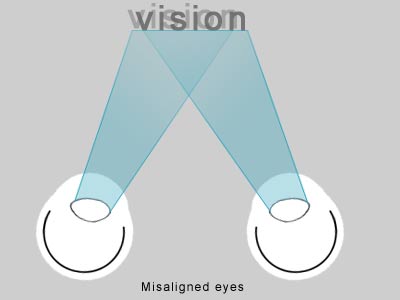 |
| Strabismus, also known as "crossed" or
"misaligned" eyes, causes double vision. |
Overview
Crossed eyes – medically known as strabismus (struh-BIZ-mus)
– refer to a condition in which muscles that control eye
movement are not properly coordinated or by problems
with the nerves that control the eye muscles or with the
brain where the signals for vision are processed. The
result is one or both eyes turn inward, outward, upward
or downward, or one or both eyes may move irregularly.
Also known as “misaligned eyes,” “wandering eyes” or
“wall eyes,” strabismus can be constant or occur
intermittently, which usually worsens when eye muscles
are tired or during illness. When the eyes turn inward
toward the nose (or crossed), the condition is called
“esotropia” – the most common form. When they turn
outward, it is called “exotropia.” When an eye turns
upward it is known as “hypertropia” and “hypotropia”
refers to an eye turned downward.
Strabismus is usually diagnosed during childhood and
affects about 4 percent of children, afflicting boys and
girls equally. But it can develop in older children or
adults as the result of injury or diseases such as a
brain disorder, diabetes, high blood pressure, multiple
sclerosis or thyroid problems.
Most infants appear to be crossed-eyed, at least
intermittently, during their first 3 months, as they are
learning to focus. Most babies outgrow this. If your
child’s eyes remain crossed or misaligned after 6
months, it may be infantile esotropia, a condition that
often results from heredity or cerebral palsy. However,
a condition often mistaken for strabismus is
pseudostrabismus, in which a widened nasal bridge or
extra fold of skin makes the white sclera appear less
visible – giving the appearance that the eyes are
crossed. This usually resolves as the infant grows and
the facial structures change.
Symptoms
The obvious signs of strabismus are eyes that appear
misaligned and don’t move together. Those with
strabismus may experience:
- Double vision
- Difficulty focusing or judging distances
- Frequent blinking or squinting, especially in
bright sunlight
- Tilting the head to look at things
- Frequent headaches
- Eye pain
- Nausea
Prevention
Strabismus cannot be prevented, but its complications
can be avoided with early intervention. Even if you
notice symptoms intermittently – when your child is ill,
stressed or fatigued – alert your eyecare provider or
pediatrician. Children should be monitored closely prior
to entering school, especially if strabismus runs in
your family. Most experts recommend an eye exam for all
children before age 6 months, and then annually starting
around age 3.
Treatment
Uncorrected strabismus represents one of the leading
causes of vision loss and blindness in children.
Generally, the younger children are when treated, the
shorter the course of treatment and the higher the
likelihood of success.
After infancy, children will not “outgrow” strabismus
so the condition must be treated as soon as possible.
When diagnosed early, correction is usually successful.
But left uncorrected, strabismus can lead to amblyopia
(lazy eye) and permanent loss of depth perception.
Before treatment is implemented, the precise cause
should be determined. Crossed eyes can be indicative of
other serious conditions such as diabetes, high blood
pressure, and neurological disorders. Because there are
many causes, treatment often involves a combination of
elements including eyeglasses, vision therapy
(orthoptics), surgery and medication.
- Eyeglasses help redirect the line of
sight, improve focusing ability, relieve some of the
symptoms, and encourage the eyes to straighten.
- Vision therapy, or orthoptics, train the
eyes to work together, often with the use of an eye
patch.
- Surgery is sometimes required to
reposition the eye muscles and restore permanent
control of the eyes. Frequently, repeat surgery must
be performed to keep the eyes aligned. Vision
therapy and corrective glasses may be prescribed
before and after surgery.
- Drug therapy is controversial and usually
considered a "last resort" treatment.
Anticholinesterase miotics are eye drops or ointment
that can enhance the focusing mechanisms of the eye.
These are used on both children and adults, but have
potential side effects such as including headaches,
tearing, blurred or clouded vision, and decreased
night vision. Botulinum toxin type A may offer an
alternative to eye-muscle surgery, but this drug is
rarely used on children, as it it injected into an
eye muscle to paralyze it, allowing the opposing
muscle to tighten and straighten the eye. The
effects of the muscle paralysis wears off, but the
eye may be permanently corrected. Side effects may
include drooping of the eyelid, and loss of vertical
eye movement.
Due to the high risk of recurrence and complications,
children with strabismus must be closely monitored long
term. Patching may continue throughout childhood.
If strabismus is not treated during childhood, the
likelihood of correction is low. Treatment in
pre-adolescents, adolescents and adults is possible but
takes longer and is less effective. In adults, treatment
may not improve eyesight at all. The condition may have
progressed into lazy eye, a condition in which the
nerves that transmit signals from the eye to the brain
degenerate and cause permanent vision loss. Surgery to
realign the muscles and straighten the eyes may be
performed for cosmetic reasons only. |